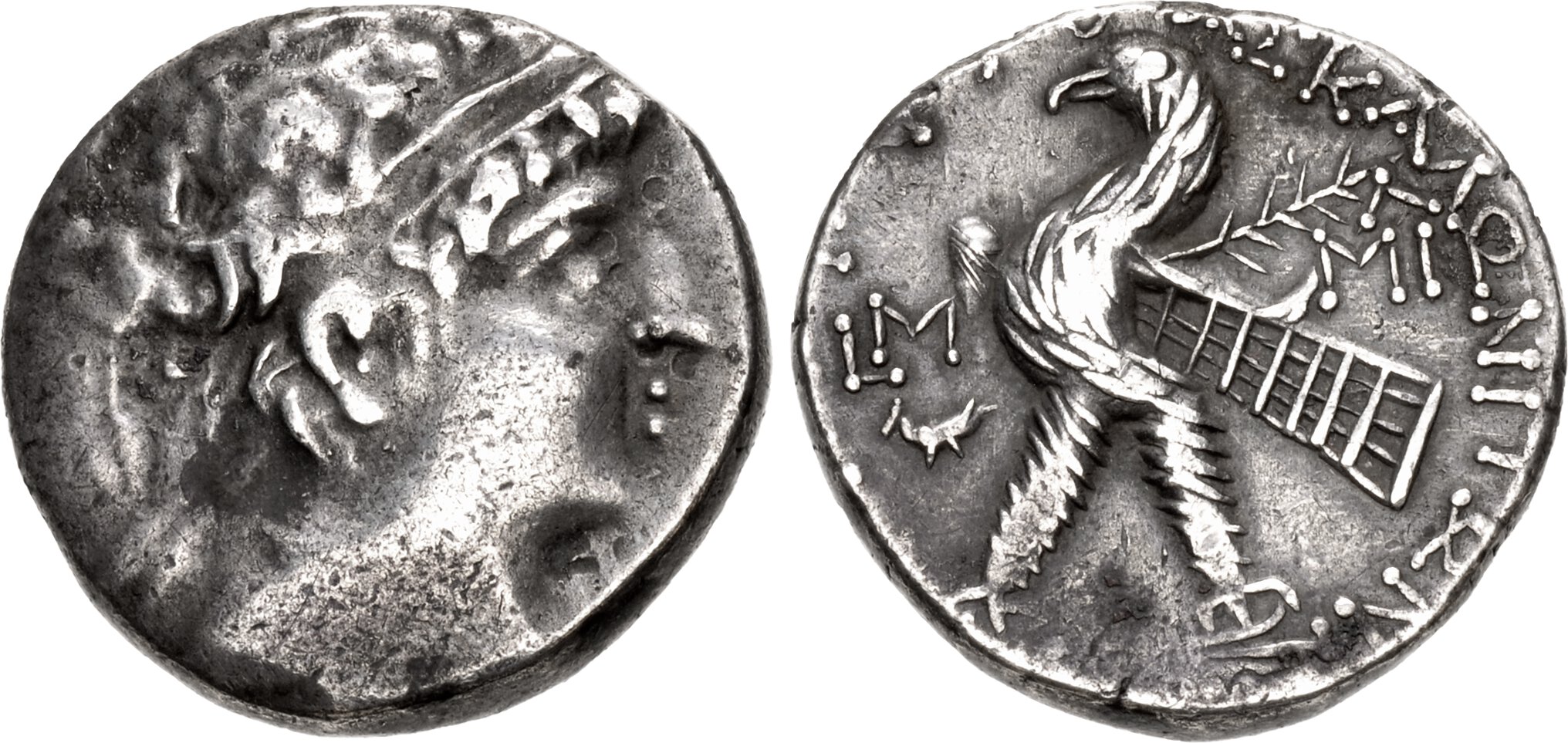Ascalon, silver, tetradrachms (Antiochus VIII/standing eagle) (99-49 BCE) Gitler - Master
From SILVER
(Redirected from S 1891 - Ascalon, silver, tetradrachms (99-49 BCE) Gitler - Master)
99 BCE - 49 BCE Silver 13,925 kg
Description
| ObverseInscription or printing placed on the obverse.: | Diademed and draped bust of Antiochos VIII right |
| ReverseInscription or printing placed on the reverse.: | AΣKAΛΩNITΩN IEPAΣ AΣKΛOYAYTO (Greek).Eagle standing left on thunderbolt, to left, LM (date) above dove standing left, to right, Λ above MI |
Mint and issuing power
| MintIdentifies the place of manufacture or issue of a numismatic object.: | Ascalon | Ancient regionAncient region.: | Phoenicia | Modern countryModern country: Israel | AuthorityIdentifies the issuing power. The authority can be "pretended" when the name or the portrait of X is on the coin but he/she was not the issuing power. It can also be "uncertain" when there is no mention of X on the coin but he/she was the issuing power according to the historical sources: | Antiochus VIII Grypus (Seleucid king, 121/0-97/6 BC), Seleucid Dynasty (312-63 BC) |
Chronology
| FromIdentifies the initial date in a range assigned in a numismatic context. | 99 BCE | toIdentifies the final date in a range assigned in a numismatic context.. | 49 BCE | PeriodTime period of the numismatic object.: Hellenistic 323-30 BC |
Physical description
| MetalThe physical material (usually metal) from which an object is made.: | Silver |
Median weightMedian of the weights of numismatic objects (in grams). in grams | 13.70 | DenominationTerm indicating the value of a numismatic object. Examples: tetradrachm, chalkous, denarius.: | tetradrachm |
StandardStandard.: | Attic |
Image

S1891 Ascalon tetradrachms.jpg [1]
References
| Die study referencePublication of the study: | Gitler - Master 20101Gitler - Master 2010, p. 73-82 | ||
| Coin series referenceReference to coin series study: | Sear II2Sear II, n° 6676, HGC 103HGC 10, n° 512-516 | ||
| Coin series web referenceCoin series web references: | |||
Obverse dies distribution
| FrequencyFrequency of specimen in distribution. ᵖ | Number of obversesNumber of obverse dies. ᵖ (o) | % (o) | Number of coinsNumber of coins. (n) | % (n) | Die nameName(s) of the die(s). |
| 1 | 19 | 52.78 | 19 | 21.59 | 2, 3, 6, 7, 8, 9, 10, 11, 12, 13, 15, 16, 17, 19, 20, 21, 23, 25, 36 |
| 2 | 8 | 22.22 | 16 | 18.18 | 4, 5, 14, 18, 29, 33, 34, 35 |
| 3 | 4 | 11.11 | 12 | 13.64 | 1, 22, 27, 31 |
| 4 | 1 | 2.78 | 4 | 4.55 | 24 |
| 5 | 2 | 5.56 | 10 | 11.36 | 26, 30 |
| 8 | 1 | 2.78 | 8 | 9.09 | 28 |
| 19 | 1 | 2.78 | 19 | 21.59 | 32 |
| Total | 36 of 36 | 100.01 | 88 of 88 | 100 |
Reverse dies distribution
no distribution is available
Quantification
| Number of obversesNumber of obverse dies. ᵖ (o) | 36 | Number of singletons (o1)The number of singleton coins. ᵖ | 20 |
| Number of reverse diesNumber of reverse dies. (r) | 65 | Number of coinsNumber of coins. (n) | 88 |
| Coins per obverse dieNumber of coins per obverse die. (n/o) | 2.44 | Coins per reverse dieNumber of coins per reverse die. (n/r) | 1.35 |
| Reverse per obverse ratioRatio of obverse dies divided by reverse dies. (r/o) | 1.81 | Percentage of singletons (o1)number of coins (n) divided by the number of singletons (o1) ᵖ | 55.56 % |
| Original number of dies (O) (Carter 1983 formula)The estimation of the number of coins according to Carter 1983 ᵖ | 50.82 | Coins struck if 20,000 as average productivity per dieCoins made if the average productivity for obverses (according to Carter) is 20,000. ᵖ | 1,016,400 |
| Original number of dies (O) (Esty 2011 formula)The estimation of the number of coins according to the singleton formula in Esty 2011 ᵖ (O) | 60.92 | Survival rate if 20,000 as average productivity per dieSurvival rate if average productivity is 20,000. ᵖ | 0.00009 |
| Coverage (o = % of O) (Esty 1984 formula)Esty 1984 - coverage (% of O) ᵖ (o = % of O) | 77.27% | Die productivity if survival rate 1/2,000Average productivity if survival rate is 1/2,000. ᵖ | 3,463.2 |
| Weight of silver (in kg) if 20,000 coins per die (O = Carter formula)Carter 1983 * Median weight * 20000 (*10 if gold or electrum) ᵖ | 13,925 kg <br /> 13,925 kg | Die productivity if survival rate 1/5,000Average productivity if survival rate is 1/5,000. ᵖ | 8,658.01 |
Remarks
Most likely one single workstation
References
- ^ Gitler, Haim - Master, Daniel M. (2010), "Cleopatra at Ascalon: recent finds from the Leon Levy expedition," Israel Numismatic Research, 5, p. 67-98.
- ^ Sear, David R. (1979), Greek coins and their values. Vol. II, Asia and North Africa, London, xlviii, p. 317-762
- ^ Hoover, Oliver D. (2010), The Handbook of Greek Coinage Series. 10. handbook of coins of the Southern Levant : Phoenicia, southern Koile Syria (including Judaea), and Arabia, Lancaster-London, lxxix, 201 p.